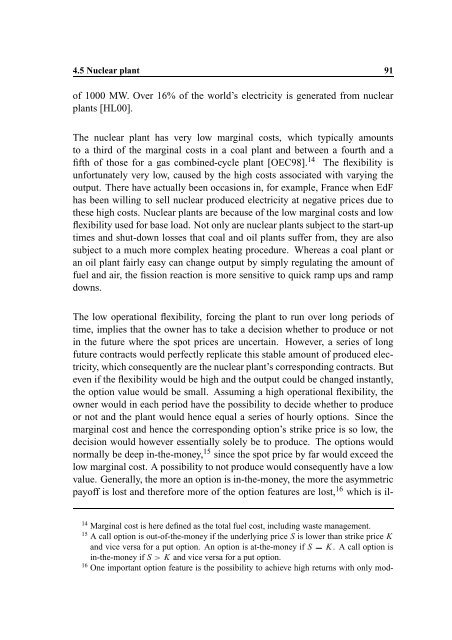Hedging Strategy and Electricity Contract Engineering - IFOR
Hedging Strategy and Electricity Contract Engineering - IFOR
Hedging Strategy and Electricity Contract Engineering - IFOR
You also want an ePaper? Increase the reach of your titles
YUMPU automatically turns print PDFs into web optimized ePapers that Google loves.
4.5 Nuclear plant 91<br />
of 1000 MW. Over 16% of the world’s electricity is generated from nuclear<br />
plants [HL00].<br />
The nuclear plant has very low marginal costs, which typically amounts<br />
to a third of the marginal costs in a coal plant <strong>and</strong> between a fourth <strong>and</strong> a<br />
fifth of those for a gas combined-cycle plant [OEC98]. 14 The flexibility is<br />
unfortunately very low, caused by the high costs associated with varying the<br />
output. There have actually been occasions in, for example, France when EdF<br />
has been willing to sell nuclear produced electricity at negative prices due to<br />
these high costs. Nuclear plants are because of the low marginal costs <strong>and</strong> low<br />
flexibility used for base load. Not only are nuclear plants subject to the start-up<br />
times <strong>and</strong> shut-down losses that coal <strong>and</strong> oil plants suffer from, they are also<br />
subject to a much more complex heating procedure. Whereas a coal plant or<br />
an oil plant fairly easy can change output by simply regulating the amount of<br />
fuel <strong>and</strong> air, the fission reaction is more sensitive to quick ramp ups <strong>and</strong> ramp<br />
downs.<br />
The low operational flexibility, forcing the plant to run over long periods of<br />
time, implies that the owner has to take a decision whether to produce or not<br />
in the future where the spot prices are uncertain. However, a series of long<br />
future contracts would perfectly replicate this stable amount of produced electricity,<br />
which consequently are the nuclear plant’s corresponding contracts. But<br />
even if the flexibility would be high <strong>and</strong> the output could be changed instantly,<br />
the option value would be small. Assuming a high operational flexibility, the<br />
owner would in each period have the possibility to decide whether to produce<br />
or not <strong>and</strong> the plant would hence equal a series of hourly options. Since the<br />
marginal cost <strong>and</strong> hence the corresponding option’s strike price is so low, the<br />
decision would however essentially solely be to produce. The options would<br />
normally be deep in-the-money, 15 since the spot price by far would exceed the<br />
low marginal cost. A possibility to not produce would consequently have a low<br />
value. Generally, the more an option is in-the-money, the more the asymmetric<br />
payoff is lost <strong>and</strong> therefore more of the option features are lost, 16 which is il-<br />
14 Marginal cost is here defined as the total fuel cost, including waste management.<br />
15 A call option is out-of-the-money if the underlying price S is lower than strike price K<br />
<strong>and</strong> vice versa for a put option. An option is at-the-money if S K . A call option is<br />
in-the-money if ® S K <strong>and</strong> vice versa for a put option.<br />
16 One important option feature is the possibility to achieve high returns with only mod-
















